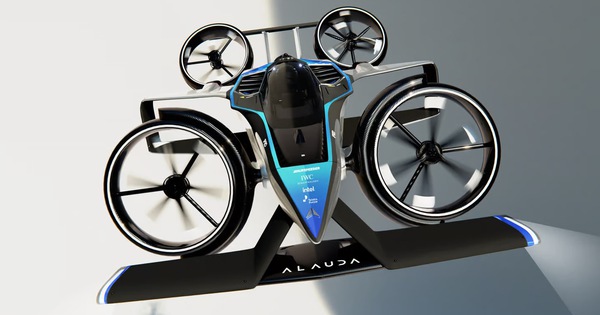AUSTRALIA The Airspeeder Mk4 is equipped with four pairs of propellers, runs on hydrogen and achieves maximum flexibility when flying fast at low altitudes.

Alauda Aeronautics revealed the design of the Airspeeder Mk4 flying racing car
Australian company Alauda Aeronautics unveiled the Airspeeder Mk4, a manned flying racing car powered by hydrogen and equipped with four pairs of propellers, Design Boom reported on February 22. This is an electric vertical take-off and landing (eVTOL) aircraft developed from Airspeeder Mk3, a remote control vehicle that has successfully performed more than 350 test flights.
While most eVTOLs are flown by tilting propellers, the Airspeeder Mk4 flies using a propulsion system designed by Alauda Aeronautics, in which an AI flight control system adjusts each pair of propellers mounted on lightweight 3D printed frames. The company said that the Airspeeder Mk4 is flown more like a fighter jet or a Formula 1 racing car than a multi-rotor helicopter.
The design team used hydrogen because it has a high energy density and can be stored in a compact form, suitable for small aircraft. “Hydrogen is also non-toxic and produces no waste except water so it doesn’t pollute the air. Also, because hydrogen is lighter than air, in the event of a leak, it will just float up and disperse into the gas. atmosphere, helping to reduce the risk of fire,” said Alauda Aeronautics.
Alauda Aeronautics presents the Airspeeder Mk4 as the world’s fastest eVTOL powered by hydrogen, with the ability to reach a top speed of 360 km/h in just 30 seconds from the start. This eVTOL model is primarily for racing purposes and is designed for maximum versatility at high speeds and low altitudes.
Designed and built in Adelaide, South Australia, the Airspeeder Mk4 has a takeoff weight of just 950 kg with an expected range of 300 km and produces virtually no emissions. The vehicle is equipped with a 1,000 kW turbine generator that powers the motors and batteries.
Alauda Aeronautics intends to begin test flights of the Airspeeder Mk4 chassis and powertrain, including the first passenger flights, in the first quarter of 2023. This flying car is expected to be completed in time to participate in the Airspeeder Racing Championship in 2024.








